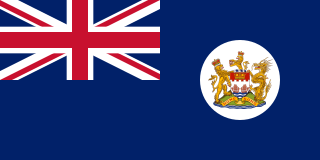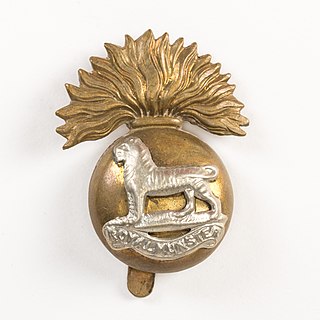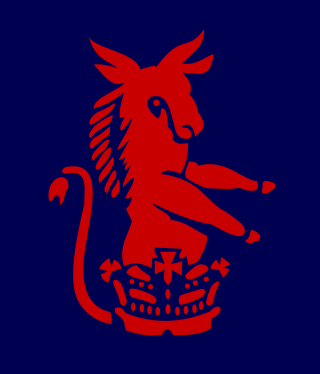Related Research Articles
The Infantry of the British Army comprises 49 infantry battalions, from 19 regiments. Of these, 33 battalions are part of the Regular army and the remaining 16 a part of the Army Reserve. The British Army's Infantry takes on a variety of roles, including armoured, mechanised, air assault and light.

The 16th (Irish) Division was an infantry division of the British Army, raised for service during World War I. The division was a voluntary 'Service' formation of Lord Kitchener's New Armies, created in Ireland from the 'National Volunteers', initially in September 1914, after the outbreak of the Great War. In December 1915, the division moved to France, joining the British Expeditionary Force (BEF), under the command of Irish Major General William Hickie, and spent the duration of the war in action on the Western Front. Following enormous losses at the Somme, Passchendaele and Ypres, the 16th (Irish) Division required a substantial refit in England between June and August 1918, which involved the introduction of many non-Irish battalions.
The 77th Indian Infantry Brigade was an infantry brigade formation of the Indian Army during World War II. It was formed in India in June 1942. The brigade was assigned to the Chindits and organised into eight columns for operations behind enemy lines in Burma. In March 1945, it was converted into the 77th Indian Parachute Brigade and assigned to the 44th Airborne Division.

British Forces Overseas Hong Kong comprised the elements of the British Army, Royal Navy and Royal Air Force stationed in British Hong Kong. The Governor of Hong Kong also assumed the position of the commander-in-chief of the forces and the Commander British Forces in Hong Kong took charge of the daily deployment of the troops. Much of the British military left prior to the handover of Hong Kong to China in 1997. The present article focuses mainly on the British garrison in Hong Kong in the post Second World War era. For more information concerning the British garrison during the Second World War and earlier, see the Battle of Hong Kong.

The Royal Irish Rifles was an infantry rifle regiment of the British Army, first created in 1881 by the amalgamation of the 83rd Regiment of Foot and the 86th Regiment of Foot. The regiment saw service in the Second Boer War, the First World War, the Second World War, and the Korean War.

The Royal Inniskilling Fusiliers was an Irish line infantry regiment of the British Army in existence from 1881 until 1968. The regiment was formed in 1881 by the amalgamation of the 27th (Inniskilling) Regiment of Foot and the 108th Regiment of Foot.

The Royal Munster Fusiliers was a line infantry regiment of the British Army from 1881 to 1922. It traced its origins to the East India Company's Bengal European Regiment raised in 1652, which later became the 101st Regiment of Foot. The Royal Munster Fusiliers were formed in 1881 by the merger of the 101st Regiment of Foot and the 104th Regiment of Foot. One of eight Irish regiments raised largely in Ireland, it had its home depot in Tralee and served as the county regiment for Cork, Clare, Limerick and Kerry. At its formation the regiment comprised two regular and two militia battalions.
The Order of battle of the Chindits, an Allied special force which carried out two deep penetration raids behind Japanese line during the Burma campaign in the South-East Asian Theatre of World War II

The Royal Munster Fusiliers was a regular infantry regiment of the British Army. One of eight Irish regiments raised largely in Ireland, its home depot in Tralee. With the outbreak of World War I in August 1914 the immediate need for a considerable expansion of the British Army resulted in the formation of the New Army under Lord Kitchener. The war target was seventy divisions in all, the New Army to have thirty volunteer divisions separate and under Army Order 324, as additional from the Regular Army, with a planned period of service of at least three years. On 7 August a general United Kingdom-wide call for 100,000 volunteers aged 19–30 was issued. The battalions were to be distinguished by the word 'Service' after their number.
The 28th Infantry Brigade was a British Army formation which served during the First World War, the Second World War, The Malayan Emergency and Indonesian Confrontation.

The 38th (Irish) Brigade, is a brigade formation of the British Army that served in the Second World War. It was composed of North Irish line infantry regiments and served with distinction in the Tunisian and Italian Campaigns. Following the end of the war, the brigade was disbanded, but was reformed in sixty years later in 2007 and remains the regional formation for Northern Ireland.
The following units of the German First Army and British Expeditionary Force fought in the Battle of Mons in World War I.
The 52nd Infantry Brigade was a formation of the British Army, which was first formed in 1914 as part of Kitchener's Army. The brigade was disbanded in 1919, but reformed in British India during the Second World War and disbanded in 1945. It was again formed in 1982, and existed until 2010.
A large regiment is a multi-battalion infantry formation of the British Army. First formed in the 1960s, large regiments are the result of the amalgamation of a number of existing single-battalion regiments, and perpetuate the traditions of each of the predecessor units.
The 155th Brigade was an infantry brigade of the British Army that saw active service in both the First and the Second World Wars. Assigned to the 52nd (Lowland) Division, the brigade saw active service in the Middle East and on the Western Front during the First World War. During the Second World War, now the 155th Infantry Brigade, it continued to serve with the 52nd Division in Operation Dynamo, and later in North-western Europe from late 1944 until May 1945.

The 31st Infantry Brigade was an infantry formation of the British Army, which participated in both the First and the Second World Wars. The brigade was later reformed after the end of the war serving in the British Army of the Rhine until the end of National Service in 1956, which saw the reorganisation of the brigade as the 11th Infantry Brigade.
The 47th Brigade was a formation of British Army. It was part of the new army also known as Kitchener's Army. It was assigned to the 16th (Irish) Division and served on the Western Front during the First World War. Philip Miles of the Indian Army briefly commanded this brigade.

This is an order of battle listing the Allied and Ottoman forces involved in the Gallipoli campaign during 1915.
The 144th Infantry Brigade was an infantry brigade of the British Army that saw active service in the First World War and again in the early stages of the Second World War before being reduced to a reserve brigade and remained in the United Kingdom for the rest of the war. In both world wars the brigade served with 48th Division.
References
- ↑ "16th (Irish) Division". The Long Long Trail. Retrieved 20 January 2012.
- ↑ Richard A. Rinaldi, Gurka Regiments in the British Army Post World War II Archived March 5, 2016, at the Wayback Machine , p.7, accessed July 2014.